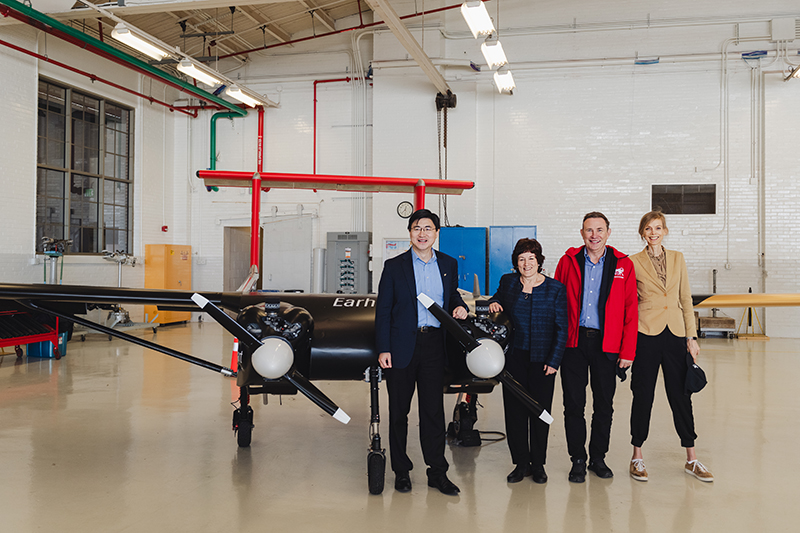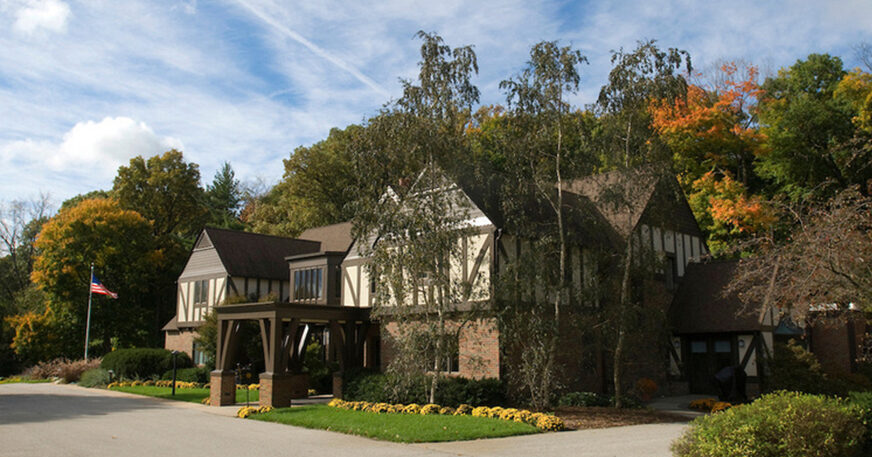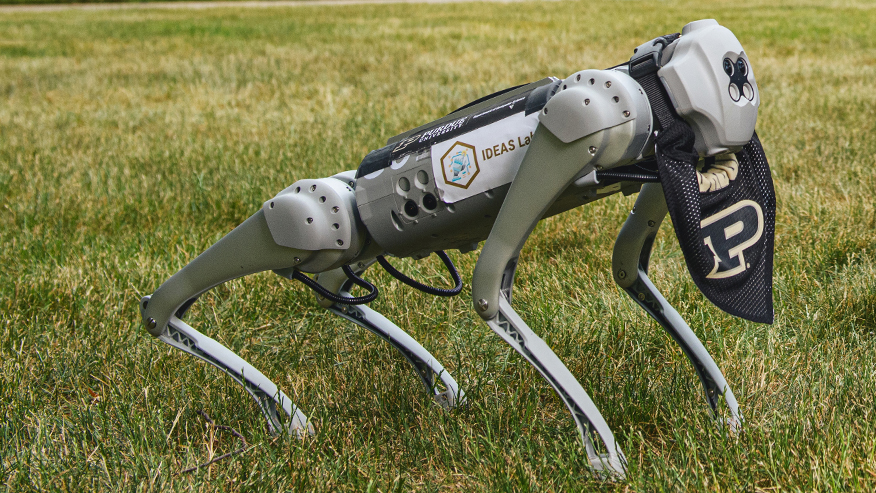Purdue launches world’s first center pioneering use of AI to innovate tomorrow’s modes of autonomous aviation transportation
Windracers, a U.K.-based global cargo vehicle operator, partners with Purdue as founding member of Center on AI for Digital, Autonomous and Augmented Aviation (AIDA3)

Purdue University and Windracers officials unveil the Windracers ULTRA, a fixed-wing, long-range aircraft, during the official launch of the Purdue-led Center on AI for Digital, Autonomous and Augmented Aviation. Known as AIDA3, the center will use the aircraft for testing in its efforts to help make autonomous unmanned aerial vehicles safer, more efficient and scalable. Pictured, from left, are Purdue President Mung Chiang; Karen Plaut, executive vice president for research at Purdue; Stephen Wright, founder and chair of Windracers; and AIDA3 director Sabine Brunswicker, a Purdue professor of digital innovation and communication. (Purdue University photo/Greta Maria Bell)
Video: “Introducing AIDA3”
Flyer: “Introducing AIDA3”
WEST LAFAYETTE, Ind. —
Indiana is the crossroads of America. Purdue University is pioneering initiatives to turn Indiana into the smart crossroads of America. By 2027, nearly 1 million commercial uncrewed aircraft systems are expected to be flying throughout the United States, doing more than delivering packages. These drones will provide key supplies for emergency services, defense, humanitarian aid and health care — even assisting in fighting wildfires.
Responding to this expected demand, Purdue is launching a pioneering center to apply artificial intelligence and machine learning (ML) to make these transportation systems safe, efficient and scalable. The Center on AI for Digital, Autonomous and Augmented Aviation (AIDA3) will deliver innovations for unmanned aerial vehicles (UAVs) and other autonomous systems, focusing on developments that can be scaled up as demand for the technology grows.

What is developed in its laboratory, based at a “smart operating center” at the Purdue University Airport, will be put into real life.
AIDA3 founding partners Purdue and Windracers bring significant strengths to quickly develop technologies for a fast-changing marketplace.
- Windracers, a low-cost logistics champion, is providing invaluable real-world experience that comes with its large-scale UAVs on its patented autopilot system for the Royal Mail, Royal Navy and the British Antarctic Survey.
- Purdue carries the heft of research expertise across several academic disciplines: polytechnic, engineering, liberal arts, science and agriculture.
Together, AIDA3 will investigate AI and ML models for autonomous transportation applications ranging from demand analytics and maintenance in commercial logistics to meteorological sensing and real-time weather prediction.
“Purdue is very proud to partner with Windracers, because AIDA3 is focused on solving pressing societal needs,” said Karen Plaut, Purdue’s executive vice president for research. “What we develop in the laboratory will be designed to make a difference when put into real-world practice. Purdue’s research strengths and success in aviation and AI — linked with Windracers’ expertise in transportation of the future — makes for a powerful innovation engine.”
ADDITIONAL INFORMATION
To support the R&D programming at AIDA3, Windracers will bring two of its fixed-wing, long-range ULTRA model UAVs to West Lafayette this spring for regular real-world testing. Measuring 20 feet by 30 feet, the ULTRA has a cruising speed of 85 mph and can take off, fly and land safely without the need of a remote pilot. The low-cost, robust and highly capable platform can carry more than 200 pounds of cargo up to 620 miles, with applications including mail and parcel delivery, humanitarian assistance, defense and environmental protection.

According to center director Sabine Brunswicker, AIDA3 is the first major output of Purdue’s Institute for Physical Artificial Intelligence (IPAI), whose purpose is to develop AI at the intersection of the virtual and physical worlds. “With IPAI, we focus on practical innovations that bring together the ‘bytes of AI’ and the ‘atoms of what we grow, make and move,’ and AIDA3 will make this reality in the realm of aviation transportation. We are thrilled to be undertaking this journey with our partners at Windracers,” Brunswicker said.
AIDA3’s approach is what sets it apart. Existing AI/ML models are not sufficiently reliable to close the loop from data to actions in the real world in a way that is safe, trustworthy and scalable, said Brunswicker, a Purdue professor of digital innovation and communication.
“Currently, it can take 10 people to operate one UAV. It is time for one operator to be able to coordinate 100 UAVs at the same time,” Brunswicker said. “Our mission is to go beyond current AI/ML models where the potential benefits of smarter UAVs can be fully realized globally. If AIDA3 is successful, its breakthroughs can truly transform society at scale.”
Said Stephen Wright, founder and chair at Windracers: “Our ambition is to revolutionize this industry so it is low cost and fully automated. Purdue is a highly respected academic institution with an incredible heritage in aviation. It also now has a major initiative to develop AI and practical applications rather than just looking at the theory. This collaboration will be the anchor of our R&D and will serve as a platform for the U.S. — a large and dynamic market that is embracing the potential of autonomous aviation.
“The center’s focus on interdisciplinary research in modeling and human-autonomy teaming, developing advanced statistical models and integrated systems that enhance safe, real-world applications and empower human-machine collaboration to overcome key challenges is a central reason why we chose Purdue as a partner,” Wright said.
About Purdue University
Purdue University is a public research institution demonstrating excellence at scale. Ranked among top 10 public universities and with two colleges in the top four in the United States, Purdue discovers and disseminates knowledge with a quality and at a scale second to none. More than 105,000 students study at Purdue across modalities and locations, including nearly 50,000 in person on the West Lafayette campus. Committed to affordability and accessibility, Purdue’s main campus has frozen tuition 13 years in a row. See how Purdue never stops in the persistent pursuit of the next giant leap — including its first comprehensive urban campus in Indianapolis, the new Mitchell E. Daniels, Jr. School of Business, and Purdue Computes — at https://www.purdue.edu/president/strategic-initiatives.
About Windracers
Windracers is making self-flying aircraft an everyday reality with a low cost and dependable platform that has been designed and built to scale. From eliminating the need for a pilot to developing a flexible platform that offers high utilization and is easy to use and maintain, its ultimate goal is to bring down the cost for the end user. Powered by its autopilot technology Masterless™, Windracers’ ULTRA UAV delivers an autonomous solution from engines on to engines off. The robust and cost-effective ULTRA (Uncrewed Low-cost TRAnsport) platform can carry 100 kilograms up to 1,000 kilometers and has short takeoff and landing capability. With a flexible payload, Windracers Group provides solutions across five sectors: mail and parcel, humanitarian assistance, defense, medical, and environmental protection.
Writer/Media contact: Phillip Fiorini, pfiorini@purdue.edu, 765-430-6189
Sources: Karen Plaut, Sabine Brunswicker, Stephen Wright
Note to journalists:



